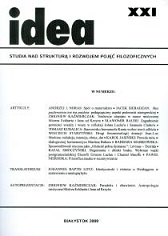Teozofia kabalistyczna w świetle spinozjańskiego monizmu panteistycznego
Kabbalistic Theosophy in the Light of the Spinozian Pantheistic Monism
Author(s): Dorota BryllaSubject(s): Philosophy
Published by: Wydawnictwo Uniwersytetu w Białymstoku
Keywords: Spinoza; Kabbalah; Judaism; Jewish mysticism; pantheism; monism; spinozism; substance; attributes; modes (modifications; modi); Ein Sof; sephirot; deity; nature; ontology
Summary/Abstract: This article presents the essential thesis from the Kabbalah theosophy, i.e. from the theosophic philosophy of the mystical Judaism, which is the monisitc view of pantheism, viz. the monistic view of the godhead, in the context of determining by it the parallel for the pantheistic, monistic philosophy of Baruch Spinoza. The elements of the philosophical systems in question, on the basis of which their analogies are shown, are the categories of substance, attributes and modes (spinozism), and Ein Sof and sephirot (Kabbalah). The deity of Spinoza, i.e. the nature (for deus sive natura), is the substance (with the quality of singularity, unity, and oneness), the infinite number of attributes and the manifested modifications (of the substance), and it is suggested in the present optics that the fundamental kabbalistc ideas as God Ein Sof and divine sephirot constitute the equivalents for them. Such correspondences are presumed due to the fact that Ein Sof is “characterized” (as far as it can be described, because Ein Sof is a product of the negative, apophatic theology/philosophy) by the descriptions specific for the Spinozian substance and its transcendental attributes, whereas the sephirot are the hypostases for the qualities that are ascribed to the comprehensible potencies from Spinoza’s pantheism: namely the two manifested attributes – res extensa and res cogitans – and the modi. What is more, the kabbalistic godhead is synonymous with the nature – as it is done in Spinoza’s system. Since the substance and the attributes with modifications, resp. Ein Sof and its sephirot, are ontologically one (they are characterized by the ontic identity), and, moreover, these categories – as a whole – set the entirety of the natural (= divine) entity, it is a well-grounded tendency to define the two analysed systems as the pantheistic monism, or monistic pantheism, which terms the present article uses.
Journal: Idea. Studia nad strukturą i rozwojem pojęć filozoficznych
- Issue Year: 2013
- Issue No: XXV
- Page Range: 25-46
- Page Count: 20
- Language: Polish

